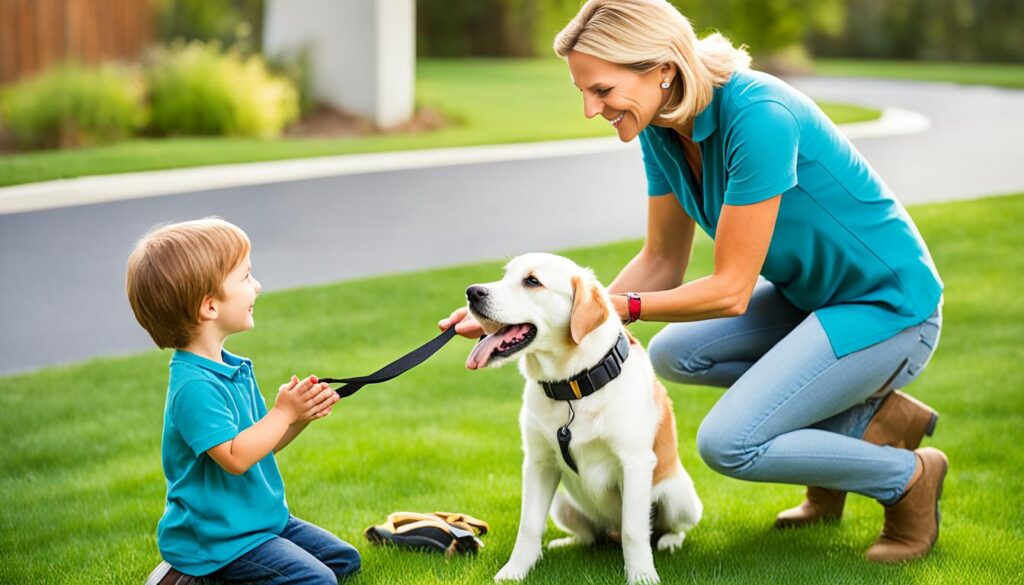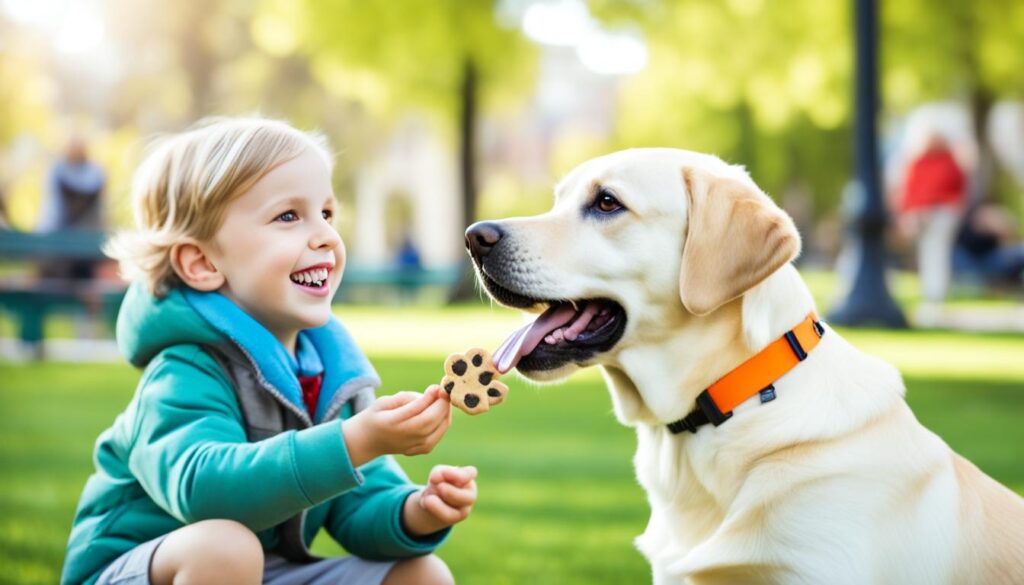Were you aware that over 4.5 million individuals are bitten by dogs annually in the United States? This is a concerning statistic that underscores the significant health threat posed by dog bites. What is even more troubling is that children are the most frequent targets, with nearly 1 in 5 bite victims needing medical treatment.
It’s essential to understand that any dog can bite, regardless of its breed, size, or age. However, the good news is that most dog bites are preventable. By taking specific steps and following safety tips, the risk of dog bites can be significantly reduced. Let’s explore some essential safety measures that can help keep you and your loved ones safe from dog bites.
Key Takeaways:
- More than 4.5 million people are bitten by dogs each year in the United States.
- Children are particularly vulnerable to dog bites, with almost 1 in 5 people bitten requiring medical attention.
- Any dog, regardless of breed, size, or age, can bite.
- Most dog bites are preventable by following specific safety measures.
Understanding Why Dogs Bite
Dogs can bite for a variety of reasons, and it is essential to understand these reasons to prevent such incidents. By recognizing the signs that indicate a dog may bite, individuals can take appropriate steps to mitigate the risk of dog bites.
There are several common reasons why dogs bite:
- Self-defense: Like humans, dogs may resort to biting as a means of self-defense when they feel threatened or cornered.
- Fear: Dogs may bite when they are scared or anxious. In these situations, they may perceive a threat even if it is unintentional.
- Feeling threatened: Dogs may feel the need to protect themselves, their territory, or their family and may bite when they perceive a threat.
- Protection of possessions: Dogs may become possessive of their toys, food, or other valuable possessions. If they feel threatened or believe their possessions are being taken away, they may resort to biting.
- Play: Dogs may use their mouths during play, but sometimes their play can escalate, leading to unintentional bites. It is crucial to teach dogs appropriate play behavior to prevent this.
Recognizing Aggression in Dogs
Understanding a dog’s body language is vital in identifying potential aggression. Here are some signs that may indicate that a dog is agitated or more likely to bite:
- Stiff and high tail: A dog with a rigid and elevated tail may be exhibiting signs of aggression.
- Corner-of-the-eye glances: Dogs that keep a close eye on someone without direct eye contact may be wary or on guard.
- Pulled back nose and wrinkled lips: A dog whose nose is pulled back, accompanied by wrinkled lips, may be preparing to bite.
- Raised hair on the neck and spine: When a dog’s hair stands up on its neck and spine, it signifies heightened arousal and potential aggression.
- Tense body: An overall tense posture, with a stiff body and muscles, may indicate a dog’s readiness to bite.
- Growling or snarling: Audible growls or snarls are clear warnings that a dog may bite if provoked further.
Being observant of a dog’s behavior and understanding the underlying reasons for their actions can help individuals react appropriately and prevent dog bites.
National Dog Bite Prevention Week®
National Dog Bite Prevention Week® is an annual event that aims to educate people about preventing dog bites. Held during the second full week of April each year, this initiative strives to raise awareness and share valuable information on how to prevent dog bites.
By participating in National Dog Bite Prevention Week® and using the #PreventDogBites hashtag, individuals can help spread this important message and contribute to the prevention of dog bites in their communities.
This week-long event brings together experts, professionals, and dog lovers from various backgrounds to promote responsible pet ownership and educate the public about dog bite prevention. Through educational campaigns, media coverage, and community events, National Dog Bite Prevention Week® strives to create a safer environment for both humans and dogs.

General Dog Bite Safety Tips
When it comes to preventing dog bites, knowledge is key. By familiarizing yourself with some general safety tips, you can significantly reduce the risk of dog bites and create a safer environment for yourself and others.
Respecting a Dog’s Space
One of the fundamental ways to prevent dog bites is to respect a dog’s space. Approaching a dog without permission or invading its personal space can make the dog feel threatened, increasing the likelihood of aggression. Teach children to always ask the dog owner before approaching a dog and to be mindful of a dog’s body language.
Avoiding Interference with Mother Dogs and Their Puppies
It is crucial to avoid interfering with mother dogs and their puppies, as they are naturally protective and may perceive any intrusion as a threat. Respecting their privacy and giving them space is essential to prevent potential aggression and ensure the safety of both the dogs and humans.
Being Cautious Around Sick or Old Dogs
When interacting with sick or old dogs, it is important to exercise caution. Dogs in pain or discomfort may react defensively if startled or touched in sensitive areas. Approach these dogs gently and cautiously, being mindful of their condition and allowing them to rest undisturbed when needed.
Understanding a Dog’s Body Language
“A dog’s body language can provide valuable insights into its mood and potential aggression.”
By understanding and interpreting a dog’s body language, you can identify signs of stress, anxiety, or aggression, allowing you to adjust your behavior accordingly. Look for cues such as stiff or tense body posture, raised hair on the neck, growling or snarling, and avoiding direct eye contact. Being vigilant and responsive to a dog’s cues can help prevent dog bites.
Follow Responsible Ownership Practices
A responsible dog owner plays a crucial role in preventing dog bites. Following responsible ownership practices, such as leash laws, proper training, and socialization, can greatly reduce the risk of aggressive behavior. Additionally, never leave children unsupervised with dogs, as even the most well-behaved dogs can become unpredictable in certain situations.
General Dog Bite Safety Tips
| Safety Tips | Description |
|---|---|
| Respect a Dog’s Space | Approach dogs with permission and be mindful of their personal space. |
| Avoid Interference with Mother Dogs and Their Puppies | Give mother dogs and their puppies privacy and space. |
| Be Cautious Around Sick or Old Dogs | Approach sick or old dogs gently, respecting their condition. |
| Understanding a Dog’s Body Language | Learn to interpret a dog’s body language to identify signs of stress or aggression. |
| Follow Responsible Ownership Practices | Observe leash laws, provide proper training and socialization, and never leave children unsupervised with dogs. |

By implementing these general safety tips, you can significantly reduce the risk of dog bites and create a safer environment for yourself, your family, and the community.
Safety Tips for Dog Owners
Dog owners have a crucial role to play in preventing dog bites and ensuring responsible pet ownership. By following these safety tips, dog owners can create a safer environment for their families and communities:
Proper Leash Control
Always keep your dog on a leash when in public areas. This helps to prevent them from approaching unfamiliar dogs, people, or dangerous situations.
Training the Dog
Ensure your dog receives proper training to understand basic commands such as sit, stay, and come. This not only improves their behavior but also allows you to control them in different situations.
Socializing the Dog
Expose your dog to different environments, people, and other animals from a young age. Gradually introduce them to new experiences to help them become comfortable and well-adjusted.
Avoiding Aggressive Games
Do not engage in games that encourage aggressive behavior, such as tug-of-war or wrestling. Instead, focus on games and activities that promote positive interaction and obedience.
Never Leaving Children Unsupervised with a Dog
Children should always be supervised when interacting with dogs. Teach them how to approach and handle dogs safely, avoiding situations that may make the dog feel threatened or uncomfortable.
“Responsible pet ownership and proper training are essential for preventing dog bites and ensuring the well-being of both dogs and humans.” – Dr. Sarah Thompson, Veterinarian
By following these safety tips, dog owners can promote responsible pet ownership and reduce the risk of dog bites. Remember, every dog has the potential to bite, but with the right precautions and care, we can create a safer environment for everyone.

| Tip | Description |
|---|---|
| Proper Leash Control | Always keep your dog on a leash in public areas |
| Training the Dog | Provide your dog with proper training to understand basic commands |
| Socializing the Dog | Expose your dog to different environments, people, and animals |
| Avoiding Aggressive Games | Do not engage in games that encourage aggressive behavior |
| Never Leaving Children Unsupervised with a Dog | Always supervise children when interacting with dogs |
What to Do If You Think a Dog Might Bite
In a situation where there is a possibility that a dog might bite, it is crucial to remain calm and take appropriate actions to ensure personal safety. By following these simple steps, one can effectively handle a potential dog bite situation:
- Stay still: Avoid making sudden movements or running away, as this may trigger the dog’s instinct to chase.
- Avoid eye contact: Direct eye contact can be interpreted as a challenge or threat by the dog. Instead, keep your gaze downwards or avert your eyes.
- Ignore the dog: By not engaging with the dog, you minimize the chances of escalating the situation further.
- Protect yourself if knocked to the ground: If the dog knocks you to the ground, curl into a ball, protect your head and neck, and cover your ears to reduce the chances of injury.
- Slowly back away: When the dog loses interest or starts to move away, slowly and calmly back away without turning your back on the dog.
Remember, every situation is unique, and these actions may not guarantee complete safety. If bitten, it is important to seek medical attention immediately. Consulting with a healthcare professional can help assess the severity of the bite and determine the need for further treatment.

Note: The image above is for illustrative purposes only and does not depict an actual dog bite situation.
Top 10 Easy Ways to Prevent Dog Bites
Preventing dog bites is vital for the safety and well-being of both humans and dogs. By implementing these easy preventive measures, the risk of dog bites can be significantly reduced.
- Spay or neuter your dog: This not only helps control pet overpopulation but can also reduce aggression in dogs.
- Correct behavior, don’t punish: Focus on positive reinforcement and reward-based training methods to teach your dog appropriate behavior.
- Socialize your dog: Expose your dog to different environments, people, and other animals from a young age to help them become well-adjusted and less likely to bite out of fear or insecurity.
- Regular exercise: Ensure your dog gets enough physical and mental stimulation through daily walks, playtime, and interactive toys. A tired dog is less likely to engage in aggressive behavior.
- Leash control: Always keep your dog on a leash when outside, especially in public places. This helps maintain control and prevents unexpected encounters that can lead to bites.
- Teach children proper interaction: Instruct children to avoid hugging, kissing, or approaching a dog’s face. Teach them to respect a dog’s space and not to disturb dogs while they are eating or sleeping.
- Be a tree if a strange dog approaches: If an unfamiliar dog approaches, teach children and even adults to stand still, with arms folded, avoiding eye contact and remaining calm until the dog loses interest and walks away.
- Avoid approaching strange dogs: It’s important to ask for permission before approaching someone else’s dog. Not all dogs are friendly, and it’s best to respect their boundaries.
- Never tease or disturb a dog: Some dogs may react aggressively if provoked or teased. Avoid pulling ears, tail, or bothering dogs in any way that may cause them discomfort or distress.
- Report dog bites: If you or someone you know has been bitten by a dog, report the incident to your local animal control or health department. This helps identify potential risks and prevent future bites.
| Easy Ways to Prevent Dog Bites |
|---|
| Spay or neuter your dog |
| Correct behavior, don’t punish |
| Socialize your dog |
| Regular exercise |
| Leash control |
| Teach children proper interaction |
| Be a tree if a strange dog approaches |
| Avoid approaching strange dogs |
| Never tease or disturb a dog |
| Report dog bites |

Conclusion
Preventing dog bites is paramount in ensuring the safety and well-being of both humans and dogs. By understanding the reasons behind dog bites, implementing general safety tips, being responsible dog owners, knowing how to handle potential dog bite situations, and adopting easy preventive measures, the risk of dog bites can be significantly minimized.
It is essential for every individual within the community to be aware and educated about dog bite prevention, creating a safer environment for all. By spreading awareness and practicing responsible dog ownership, we can work towards a future where dog bites are rare occurrences.
Remember, dog bites are preventable. By following the tips and guidelines provided in this article, we can protect ourselves, our loved ones, and our furry companions from the physical and emotional trauma associated with dog bites. Let us join hands to create a society where dogs and humans can coexist harmoniously and safely.










